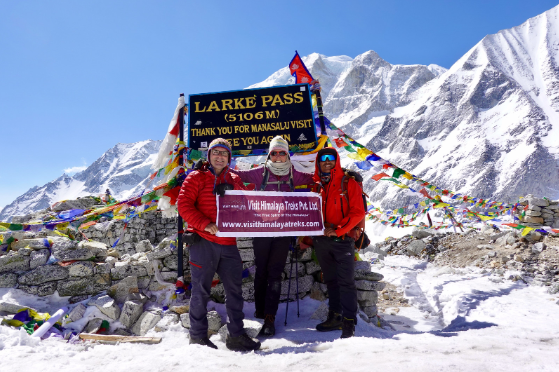Tucked in the heart of the Nepalese Himalayas, the Manaslu Circuit trek remains one of the most charming and underrated trekking courses in Nepal. Named after the world’s eighth-highest peak, Mt. Manaslu (8,163 meters), this circuit offers a profound plunge into wild snow-capped excellence, wealthy Buddhist culture, and tough Himalayan Adventure. Not at all like the intensely trafficked Everest or Annapurna districts, the Manaslu Circuit is still generally untouched, making it culminate for trekkers looking for isolation, realness, and glory in nature.
This trek circles the whole Manaslu massif and brings you face-to-face with antiquated cloisters, chortens, Mani wall, flawless icy masses, profound stream gorges, and sensational high passes like the Larke Pass, 5106 meters. Along the way, trekkers walk through terraced farmlands, subtropical woodlands, and farther Tibetan-influenced towns that speak a dialect of effortlessness and neighborliness. The Manaslu Circuit is more than a trek; it’s an endeavor into the soul of the Himalayas.
Manaslu Larke Pass trek:
Among the highlights of the Manaslu region is the Larke Pass (5,160 meters), the most elevated and most challenging point of the trek. The Manaslu Larke Pass trek is not fair, almost rising a tall Himalayan pass—it’s almost crossing into an unused domain of rough, wild, and unmatched all-encompassing magnificence. Larke La acts as a normal divider between the Manaslu and Annapurna ranges, and from the base, trekkers are rewarded with clear views of Himlung Himal, Cheo Himal, and Annapurna.
This segment of the trek tests your perseverance, particularly in the more slender discuss over 5,000 meters, but it’s also where the genuine magnificence of the Manaslu region unfurls in its rawest form. The path driving up to the pass is farther, frosty, and sensational, with periodic sightings of blue sheep, Himalayan tahr, and indeed snow panthers in the higher elevations. Once you overcome the pass and slip into the calmer landscapes close to Bimthang, the feeling is one of sheer triumph and awe.
A Social Travel Through Old Himalayan Settlements
What makes the Manaslu Circuit particularly unmistakable is its solid conservation of Tibetan Buddhist culture. As the path approaches the higher rises, especially around the towns of Samagaun, Lho, and Samdo, the social scene starts to alter drastically. Supplication wheels, unpredictably carved Mani stones, shuddering supplication banners, and antiquated religious communities rule the path. The individuals of this region are ethnically Tibetan, and their way of life has remained generally unaltered for centuries
Visiting the town of Lho, trekkers get there to begin with the up-close sea of Manaslu’s cold arch, along with the opportunity to visit Ribung Gompa, a shocking religious community roosting on a hill. In Samagaun, the heart of the upper Manaslu region, you’ll feel as though you’ve ventured into a diverse world. Here, yaks brush calmly in snow-capped glades, and local people turn supplication wheels as they walk around the village’s chorten. It’s a way to moderate down, breathe profoundly, and splash in the most profound sense of being in the mountains.
Moreover, Samdo, the final town some time recently Larke Pass, is an intriguing settlement where the ancient trade routes to Tibet start. Here, local people still engage in cross-border exchange, and the nearness of Tibetan tongues and traditions makes the town feel socially unique.
Best Time to trek the Manaslu Circuit:

Timing your Manaslu Adventure is key to getting the charge out of its characteristic and social abundance. The best time to trek the Manaslu Circuit falls into two major windows: spring (March to May) and harvest time (late September to December). These periods offer the most steady climate, clear skies, and secure path conditions for the high-altitude intersections like Larke La Pass.
In spring, trekkers can anticipate blooming rhododendrons, cascading waterfalls from softening snow, and a scene turning greener with life. Temperatures are good, particularly at lower elevations, whereas the seeds of Manaslu and neighboring peaks stay stunningly sharp in the fresh mountain air.
Autumn, on the other hand, is frequently considered the ideal season due to its dry climate and reliably clear skies. Post-monsoon freshness revitalizes the landscape, and perceivability is at its best. The cooler temperatures make long days of climbing more comfortable, particularly as you climb to the higher regions.
While it’s actually conceivable to trek in winter (December to February), overwhelming snow can make the Larke Pass unsafe or blocked. Essentially, the rainstorm season (June to early September) brings dangers of avalanches and leeches, with trails getting slippery and clouds darkening mountain views. Consequently, arranging your trek amid the two essential windows guarantees a more secure and more pleasant trek.
Manaslu Circuit trek package:
Opting for a Manaslu Circuit trek package guarantees a smoother and more fulfilling experience, particularly for those new to high-altitude trekking. These packages regularly incorporate experienced guides and Trek supporters, licenses, transportation, settlement in teahouses, and meals, providing an all-in-one arrangement for worry-free travel. Choosing a guided package also gives trekkers access to social experiences and neighborhood information that enhance the trekking experience.
Most Manaslu Circuit trek packages start and conclude in Kathmandu, and incorporate basics like the Limited Range Allow, Manaslu Conservation Zone Allow (MCAP), and Annapurna Preservation Zone Allow (ACAP). The guides that go with you are ordinarily certified and well-versed in mountain security, to begin with, help, and altitude-related precautions.
Another major advantage of going with a package is the calculated comfort. This trek passes through inaccessible regions where finding nourishment, lodging, or crisis help can be challenging on your claim. With a guided trek, you have to bolster each step of the way—from orchestrating comfortable teahouses to guaranteeing convenient acclimatization stops. Numerous packages moreover incorporate a point-by-point trekking arrangement custom-fitted to your pace and involvement level.
Manaslu Circuit trek Taken a toll:

The cost of the Manaslu Circuit trek can shift depending on the trekking company, the services advertised, the gear measure, and the season. Normally, a fully-guided Manaslu trek package costs between $1,200 and $2500 per individual for a 14- to 20-day trip. This regularly incorporates transportation (like a private jeep from Kathmandu to Machha Khola and back from Dharapani), all grants, guide and porter expenses, teahouse settlement, and three meals a day.
Here’s a fast breakdown of major cost components:
Restricted Region Allow: $100 for the to begin with 7 days (Sept–Nov), $75 (Dec–Aug), furthermore $15/day for additional days.
Manaslu and Annapurna Licenses (MCAP + ACAP): Around $60 total.
Guide and porter: Guides charge around $30–40 per day, Helpers, Porters around $20–30.
Transportation: Shared jeep or transport (~$30–$50 one way).
Food and Lodging: Included in most packages, but if traveling autonomously, anticipate $35 –$50/day.
Additional costs may include equipment rental, individual costs (like Wi-Fi, hot showers, or snacks), tipping, and travel protections. Whereas it may appear exorbitant compared to other Nepal treks, the remoteness and licenses make it marginally more expensive, but without a doubt worthwhile.
Physical Challenge Meets Otherworldly Reward
The Manaslu Circuit trek is considered moderately challenging. It requires a great level of wellness and the capacity to trek for 5–7 hours day by day over changed terrain. As the elevation rises, particularly past 3,000 meters, acclimatization gets to be basic. Guided treks ordinarily incorporate rest days in Samagaun or Samdo to permit your body to adjust to the more slender air.
Despite the physical exertion, most trekkers discover that the otherworldly vitality of the Manaslu region gives them the quality to push forward. Supplication banners ripple in the mountain breeze, local people offer warm grins, and each step brings a modern vista or social diamond. There’s a special agreement in how nature, convention, and challenge coexist in the Manaslu region.
Why Select the Manaslu Circuit Over Other Treks?
If you’re choosing between Nepal’s celebrated trails—like Everest or Annapurna—and Manaslu, here’s what sets Manaslu separated: realness, remoteness, and social lavishness. Not at all like the busier trails of the Khumbu or Annapurna, Manaslu offers a calmer and more immersive Himalayan experience. There are fewer teahouses and visitors, which implies each sea feels individual and each experience is more genuine.
The scene is inconceivably assorted, transitioning from green waterway valleys to snowbound snow capped vistas. The social encounter is similarly profound, impacted intensely by Tibetan Buddhism and Himalayan conventions. You don’t fairly climb through the mountains—you walk through centuries of protected culture, where each cloister, Mani divider, and town tells a story.
Trek Capably: Preservation and Respect
Since the Manaslu region is a limited range, the trek is guided for great reasons—it encompasses both the delicate environment and the interesting culture of the individuals. Trekkers are energized to travel mindfully, respect nearby traditions, and decrease the natural impact. Continuously carry reusable bottles, dodge plastic packaging, and bolster locally run teahouses.
Tourism plays a key part in supporting the towns of Manaslu. When you enlist a neighborhood guide, purchase from town shops, or remain in teahouses, you specifically contribute to the local economy. By choosing a capable trekking organization and following Take off No Follow standards, you offer assistance to keep the Manaslu Circuit wild and excellent for generations to come.
Conclusion:
The Manaslu Circuit trek is not a physical trek; it’s a profound experience through wild Himalayan scenes and antiquated societies. Whether it’s crossing the frigid Larke Pass, sharing a feast with a nearby family in Samdo, or spending some time recently the monstrous white divider of Manaslu itself, the encounter clears your mind.
For those looking to go off the beaten path, plunge into further Himalayan magnificence, and interface profoundly with the region’s otherworldly quintessence, the Manaslu Circuit is unparalleled. From its tough trails to its sacrosanct cloisters, this trek conveys the idealized blend of nature, culture, and adventure.
FAQs
- Is the Manaslu Circuit appropriate for beginners?
Yes, with appropriate wellness and a guided trek, fledglings can effectively complete the trek.
- Do I require a license to trek to Manaslu?
Yes, you require the Confined Zone Allow, Manaslu Preservation Region Allow, and Annapurna Preservation Zone Permit.
- How long is the trek?
The trek ordinarily takes 14 to 20 days, depending on acclimatization and side trips.
- Is the path crowded?
No, it is one of the slightest swarmed treks in Nepal, advertising isolation and authenticity.
- Can I trek solo?
No, solo trekking is not permitted in Manaslu. You must be in a group of at least two with an authorized guide.
Booking Process for Manaslu Circuit Trek with Visit Himalaya Treks
To book the Manaslu Circuit Trek through Visit Himalaya Treks, begin by contacting them via email or WhatsApp to discuss your preferred dates, group size, and specific needs. VHT will provide a detailed itinerary covering the duration of the Manaslu Larke Pass Trek, highlights, costs, and inclusions such as a guide, porter, meals, accommodation, and transportation.
We, Visit Himalaya Treks, will finalize all logistical arrangements, including transportation, accommodation, and permits, to ensure everything is in place for your trek. Upon arrival in Nepal, the team will ensure that all aspects of the trek are organized, providing you with a smooth and unforgettable experience on the trek to Manaslu Circuit, visiting the Base Camp of Mount Manaslu. Our company specializes in pure off-the-beaten-path destinations like the Kanchenjunga Base Camp Trek in eastern Nepal, one of the most beautiful treks in Nepal. Similarly mesmerizing Mount Makalu Base Camp Trek or any other Himalaya Trekking Tours in Nepal.

